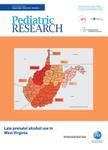版权所有:内蒙古大学图书馆 技术提供:维普资讯• 智图
内蒙古自治区呼和浩特市赛罕区大学西街235号 邮编: 010021

作者机构:Inst Child Hlth Vasc Biol & Pharmacol Unit London WC1N 1EH England
出 版 物:《PEDIATRIC RESEARCH》 (儿科研究)
年 卷 期:1999年第46卷第4期
页 面:411-418页
核心收录:
学科分类:1002[医学-临床医学] 100202[医学-儿科学] 10[医学]
主 题:年龄因素 动物 新生 缺氧/病理生理学 心钠素/代谢 心钠素/药理学 结合部位 环GMP/代谢 胎儿/生理学 高血压 肺性/病理生理学 利钠肽 C型/药理学 肺动脉/药物作用 肺动脉/生长和发育 肺动脉/生理学 野猪 血管阻力/药物作用 血管舒张药/药理学 动物
摘 要:Pulmonary vascular resistance falls rapidly after birth, but endothelium-dependent relaxation is relatively poor during the perinatal period. Atrial natriuretic peptide (ANP) is a potent vasodilator;however, its role in the process of perinatal adaptation is uncertain. Porcine intrapulmonary conduit arteries (IPA) from fetal, newborn (5 min), 3-, 6, and 17-d-old, and adult pigs, and from piglets made hypoxic from 0 to 3, 3 to 6, or 14 to 17 d, were isolated and mounted for isometric force recording. Rings were precontracted with prostaglandin-F-2 alpha (PGF(2 alpha), 10 mu M) or KCl (40 mM). ANP was added cumulatively (10 pM to 100 nM). C-type natriuretic peptide (CNP) was added as a single concentration of 100 nM. Accumulation of cGMP under basal conditions and stimulated by ANP or CNP was measured by radioimmunoassay system. Frozen sections of lung tissue were incubated with I-125-labeled alpha-ANP, and binding site density was assessed on IPA with an image analysis system. ANP relaxed IPA in pigs at all ages, but the effect was significantly greater at 6 and 17 d of age. Hypoxia in animals from 14 to 17 d old impaired ANP-induced relaxation. CNP relaxed IPA poorly: 12% at all ages. ANP increased cGMP accumulation in both normal and hypo:tic animals. CNP did not increase cGMP generation in IPA fi om normal animals but did so in IPA from 3-d-old hypoxic animals. ANP-specific binding sites were demonstrated on the pulmonary artery smooth muscle cells, with greater binding in the young animals. The increased relaxant responses to ANP during adaptation may be important in maintaining low pulmonary vascular resistance. In contrast, CNP was largely ineffective in relaxing pulmonary arteries.